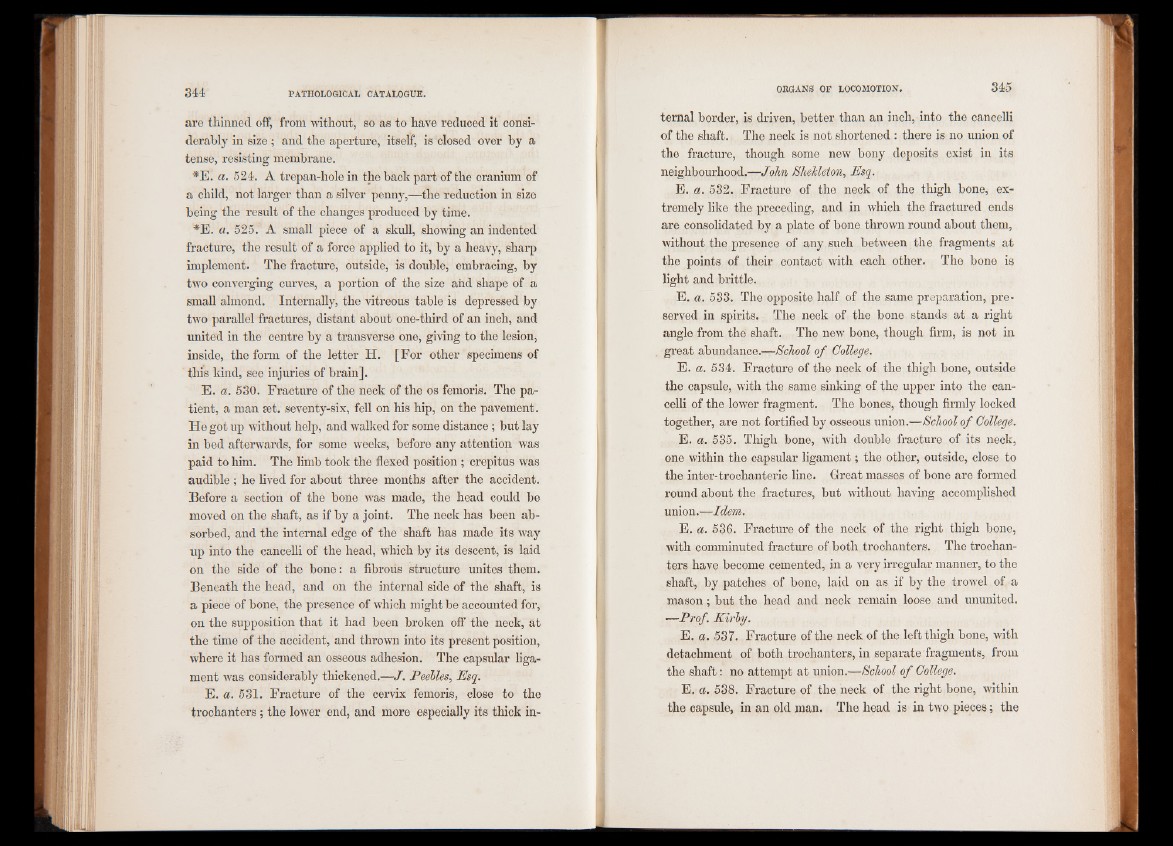
are thinned off, from without, so as to have reduced it considerably
in size ; and the aperture, itself, is closed over by a
tense, resisting membrane.
*E. a. 524. A trepan-hole in the back part of the cranium of
a child, not larger than a silver penny,—the reduction in size
being the result of the changes produced by time.
*E. a. 525. A small piece of a skull, showing an indented
fracture, the result of a force applied to it, by a heavy, sharp
implement. The fracture, outside, is double, embracing, by
two converging curves, a portion of the size and shape of a
small almond. Internally, the vitreous table is depressed by
two parallel fractures, distant about one-third of an inch, and
united in the centre by a transverse one, giving to the lesion,
inside, the form of the letter H. [For other specimens of
this kind, see injuries of brain].
E. a. 530. Fracture of the neck of the os femoris. The patient,
a man ret. seventy-six, fell on his hip, on the pavement.
He got up without help, and walked for some distance; but lay
in bed afterwards, for some weeks, before any attention was
paid to him. The limb took the flexed position ; crepitus was
audible ; he lived for about three months after the accident.
Before a section of the bone was made, the head could be
moved on the shaft, as if by a joint. The neck has been absorbed,
and the internal edge of the shaft has made its way
up into the cancelli of the head, which by its descent, is laid
on the side of the bone: a fibrous structure unites them.
Beneath the head, and on the internal side of the shaft, is
a piece of bone, the presence of which might be accounted for,
on the supposition that it had been broken off the neck, at
the time of the accident, and thrown into its present position,
where it has formed an osseous adhesion. The capsular ligament
was considerably thickened.—J. Peebles, Esq.
E. a. 531. Fracture of the cervix femoris, close to the
trochanters; the lower end, and more especially its thick internal
border, is driven, better than an inch, into the cancelli
of the shaft. The neck is not shortened : there is no union of
the fracture, though some new bony deposits exist in its
neighbourhood.—John Shekleton, Esq.
E. a. 532. Fracture of the neck of the thigh bone, extremely
like the preceding, and in which the fractured ends
are consolidated by a plate of bone thrown round about them,
without the presence of any such between the fragments at
the points of their contact with each other. The bone is
light and brittle.
E. a. 533. The opposite half of the same preparation, preserved
in spirits. The neck of the bone stands at a right
angle from the shaft. The new bone, though firm, is not in
great abundance.—/School of College.
E. a. 534. Fracture of the neck of the thigh bone, outside
the capsule, with the same sinking of the upper into the cancelli
of the lower fragment. The bones, though firmly locked
together, are not fortified by osseous union.—School of College.
E. a. 535. Thigh bone, with double fracture of its neck,
one within the capsular ligament; the other, outside, close to
the inter-trochanteric line. Great masses of bone are formed
round about the fractures, but without having accomplished
union.—Idem.
E. a. 536. Fracture of the neck of the right thigh bone,
with comminuted fracture of both trochanters. The trochanters
have become cemented, in a very irregular manner, to the
shaft, by patches of bone, laid on as if by the trowel of a
mason; but the head and neck remain loose and ununited.
—Prof. Kirby.
E. a. 537. Fracture of the neck of the left thigh bone, with
detachment of both trochanters, in separate fragments, from
the shaft: no attempt at union.—School of College.
E. a. 538. Fracture of the neck of the right bone, within
the capsule, in an old man. The head is in two pieces; the